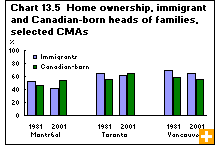Common menu bar links
Immigrant home ownership slips
Archived Content
Information identified as archived is provided for reference, research or recordkeeping purposes. It is not subject to the Government of Canada Web Standards and has not been altered or updated since it was archived. Please contact us to request a format other than those available.
Home ownership declined markedly among immigrant families in some cities from 1981 to 2001, particularly among families with a main wage earner aged 25 to 54.
Some of the decline is linked to immigrants’ poorer fortunes in the labour market. Length of time in Canada is also a factor: in 2001, 37% of immigrants had lived here 10 or fewer years, compared with only 30% in 1981. Age is another factor: immigrants aged 45 to 54 had higher home-ownership rates from 1981 to 2001 than the Canadian-born population in the same age group. In this period, immigrants aged 35 to 44 saw their home-ownership rates fall. By 2001, the rate for immigrants 35 to 44 had dropped below that of Canadian-born in the same age group.
In Montréal, 52% of immigrant families owned their own home in 1981, compared with 46% of Canadian-born families. In Toronto, 65% of immigrant families owned homes, compared with 55% of Canadian-born families. In Vancouver, 70% of immigrant families owned their homes; 58% of Canadian-born families did so.
By 2001, the situation had reversed in Montréal (42% of immigrant families owned homes versus 54% of Canadian-born families) and in Toronto (61% versus 64%). The picture in Vancouver did not change (64% versus 55%).
Housing was a particular problem for immigrants who arrived from 1996 to 2001. Some of these immigrants found quality housing to be out of their reach. They ended up in ‘core housing need.’ In other words, they were living in rented dwellings that needed major repairs, were overcrowded or that required them to spend 30% or more of their before-tax income on rent.



